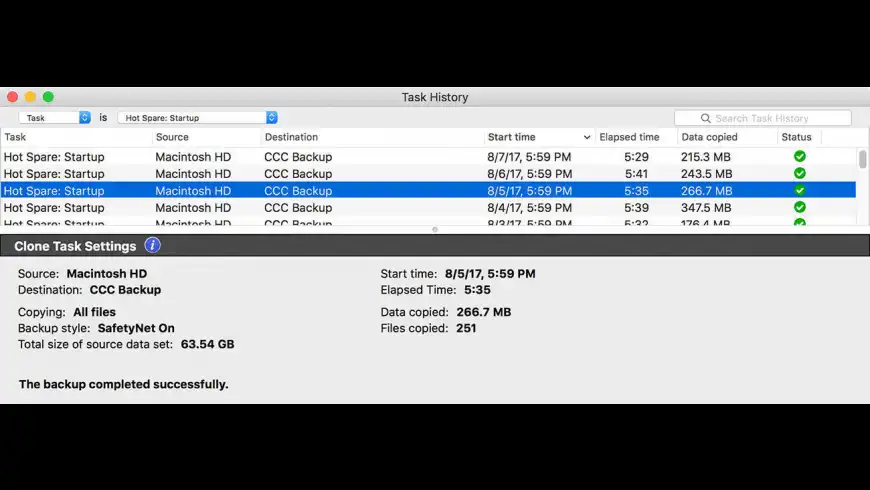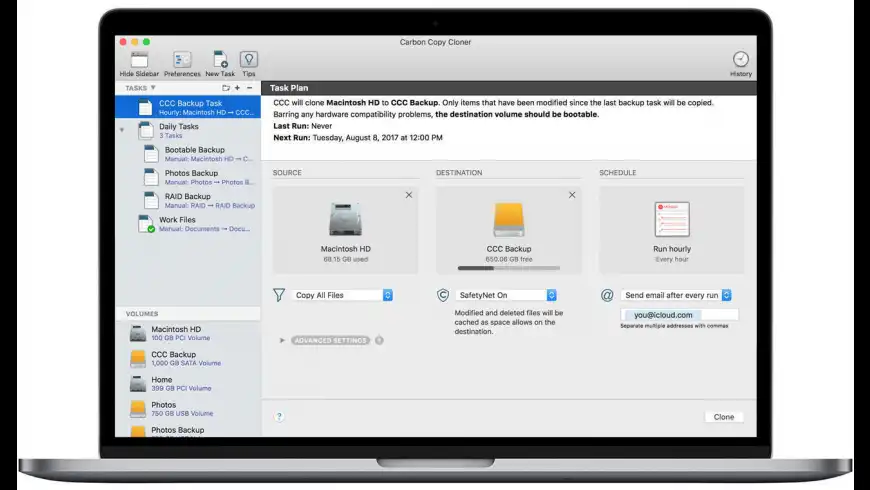Carbon Copy Cloner Alternatives for Mac. There are many alternatives to Carbon Copy Cloner for Mac if you are looking to replace it. The most popular Mac alternative is Clonezilla, which is both free and Open Source.If that doesn't suit you, our users have ranked more than 25 alternatives to Carbon Copy Cloner and 12 are available for Mac so hopefully you can find a suitable replacement. I’d like to take this opportunity to say I’ve been extremely happy with Carbon Copy Cloner and Bombich Software over the four years I’ve been a customer. CCC is a truly outstanding piece of crafted software with top-notch support (I love the integrated help and support features) offered by a reliable and professionally-run company.
/PowerMyMac /Guide on How to Clone Mac Hard Drive to SSD
When it comes to the cloning topic, what do you expect from the process? If you are planning to clone Mac hard drive to SSD, let us take a close look at what is the cloning process all about. Generally, it is recommended to clone the hard drive of your Mac in case you decide to upgrade the hard drive with a solid state drive (SSD), replace an old or corrupted drive with a new one or if you are going to create a bootable hard drive.
In most cases, all these demands can be achieved with the help of cloning. Essentially, when you clone the hard drive, you will no longer worry about reinstalling the operating system as well as transfer folders, files, applications and some configurations on the new hard disk. Another advantage with the cloning process is that if you have a duplicate hard drive with setup volume, it can aid in booting your Mac easily in case of unexpected disasters.
- Feb 20, 2021 Carbon Copy Cloner for Mac is sometimes referred to as 'Carbon Copy Cloner 1,1', 'Carbon Copy Cloner b3', 'Carbon Copy Cloner copy'. The common filenames for the application's installer are ccc-4.0.2.3517.zip, ccc-4.0.3.3847.zip, ccc-3.5.dmg, ccc-3.5.1.dmg or ccc-3.5.2.zip etc.
- With Carbon Copy Cloner, your data and the operating system's data are all preserved on a bootable volume, ready for production at a moment's notice. When disaster strikes, simply boot from your backup and get back to using your Mac.
- Then, once your Mac is fully loaded, run Carbon Copy Cloner and choose your settings carefully. 'Source Disk' should now be your CCC backup and 'Target Disk' will be your Mac's main hard-drive. Go through the warnings again and read the text beneath “What is going to happen?” again.

Article GuideWhat Are Solid State Drives (SSDs)?How to Clone Mac Hard Drive to SSDShould I Backup or Clone?Let's Wrap It up
What Are Solid State Drives (SSDs)?
Before you decide to clone Mac hard drive to SSD, let us take a close look at SSDs. Solid state drives or SSDs utilize flash memory to keep data. If built into a computer, they are usually seen as chips on the circuit board. You can also find them in 2.5” format that you can install in a laptop or an external enclosure.
Generally, SSDs are quiet, compact and fast, especially if you are starting up a computer or waking up the device. Remember that hard disks might go into sleep mode when not used for a certain span of time and takes a few seconds to spin up. SSDs also utilize less power, run cooler, lighter and do not have any movable parts which make them suitable for laptops.
When you accidentally drop your laptop when the hard drive is spinning, there is a likelihood for the drive to be damaged and lose data. SSDs are generally more dependable, and in case they fail, you can still read data whereas you cannot do this with a hard disk.
Nevertheless, SSDs are considered as a costly option if you are considering the cost to storage ratio. At present, you can purchase an 8TB external drive for less than $150 while that same amount of money will only provide you with a 500GB SSD.
People Also Read:How to Partition A Hard Drive on Mac?How to upgrade your MacBook Pro with an SSD?
How to Clone Mac Hard Drive to SSD
There are several reasons why it is best to boot from an external hard drive. In case you prefer to keep your files synchronized from a desktop and laptop, enlarge your storage or have an on-hand bootable backup duplicate of your system, there is an unseen feature in Disk Utility that makes the process an easy task.
Essentially, booting from an external hard drive is usually slower, even if you are using the latest Thunderbolt or the USB-C drives. They are relatively sluggish than the solid state drives (SSDs) that are found in most of the latest Macs. Although this is not suggested for daily use, it is a possible option.
Using Disk Utility
If you are going to clone Mac hard drive to SSD, it is recommended to use Disk Utility.Simply open Disk Utility from the Spotlight (Command+Space) or on the Utility folder in your applications. You will be presented with a list of all the volumes including the internal hard drive and the external hard drive.
It is important to note that the “Restore” option in Disk Utility will work by copying the files from the backup to your core drive. It is ideally intended to the utilized for Recovery mode to reinstate the hard drive in case a failure occurs.
Once you decide to set your external drive as the restore target, you can switch that action around and copy files from the main drive to the backup. Choose your external drive in the sidebar, tap on the “Restore” button in the menu and select your main drive as the “Restore From” option. You have the option to choose an ISO image, but it does not have much use.
Tap on the “Restore” button and Disk Utility will initiate the copying process. In most cases, the process is relatively a long one which is based on the speediness of your external drive as well as its link to your Mac. Due to this, it is recommended to have a rapid hard drive with USB-C, Thunderbolt or USB 3.0 connections.
Once Disk Utility completes the task, you can turn off your Mac and press on the Option when it starts to restart again. You will be presented with the boot switcher and you are allowed to boot from the external hard drive. You can utilize your Mac as usual but remember that it is separate from the installation on the main internal hard drive. Take note that any settings that you alter or files that are saved there will not be reflected on the primary installation.
You can perform the same process in a reverse manner if there is a need to copy the files back over or to restore the backup in case your computer malfunctions.
Should I Backup or Clone?

Generally, hard disks can be backed up or cloned. Remember that there are differences between the two with their own advantages and drawbacks.

Backing up a hard drive
If you are going to back up a hard drive, the entire content of the chosen drive or partition is backed up into a file on the targeted location. All data is saved into a single file. When a complete backup of the hard drive is carried out, the whole operating system along with the installed applications and settings are also set aside. The file can be protected or encrypted with a password.
The advantage of this approach is no other than simple management since a single file contains the whole backup. You can also compress the backup file so that it utilizes less space.
As for a drawback, you need a backup software to be able to reinstate the system or data to a previous state or to access documents and files.
Cloning the hard drive
If you are going to duplicate or clone Mac hard drive to SSD, a copy of the drive is created directly on the target location. N53 asus for mac. This simply means that you have an instant copy including the hard disk structure. A cloned disk or drive includes all the partitions from the source drive or disk.
An advantage with cloning is that the data is directly copied to the specified location and can be utilized and edited directly. The duplicated system drive which includes the operating system can be mounted as a fresh drive and booted right away.
Carbon Copy Mac Os

As for the drawbacks, a clone requires more space since the partitions are created immediately on the targeted disk. Due to this, it is not likely to compress or add encryption to the data.
Let's Wrap It up
If there is a need for a backup to be created regularly, it is recommended to opt for the hard drive backup. This usually takes up less space and allows the creation of extra backups.
In case you require a bootable extra drive to be operational after an unforeseen crash and to lessen the downtime period, it is best to clone Mac hard drive to SSD.
Generally, both methods have been proven to be the ideal choice. A consistent drive backup for daily data along with a clone of the system drive is essential for easy accessibility in case of emergencies.
ExcellentThanks for your rating.
Rating: 4.5 / 5 (based on 87 ratings)
People Also Read:
PowerMyMac
Carbon Copy Cloner For Mac
A powerful all-in-one App for Mac
Free DownloadClean up and speed up your Mac with ease
Free DownloadCarbon Copy Cloner is a popular software that lets Mac users easily back up entire disks and partitions on macOS. As macOS Big Sur is about to be released to the public, the developers behind Carbon Copy Cloner have now alerted their users about potential compatibility issues with the latest version of Apple’s operating system.
With Carbon Copy Cloner, users can create advanced backups of a Mac hard drive while still keeping it functional and bootable, which is great to ensure you’ll never lose your data. However, macOS Big Sur brings fundamental changes to the way the Mac manages its volumes, and this impacts software like the Carbon Copy Cloner.
One of the main under the hood features introduced with macOS Big Sur is a new protection layer called “Signed System Volume” that seals and encrypts the volume in which macOS is installed. Third-party tools can still make backups of the Mac’s internal storage, but they’re not bootable and some things become inaccessible.
The system now resides on a “Signed System Volume”. This volume is cryptographically sealed, and that seal can only be applied by Apple; ordinary copies of the System volume are non-bootable without Apple’s seal. To create a functional copy of the macOS 11 System volume, we have to use an Apple tool to copy the system, or install macOS onto the backup.
The latest version available of Carbon Copy Cloner (5.1.22) works with macOS Big Sur, but it’s only capable of creating copies of the system volume that are not bootable. The developers responsible for the software have claimed that Apple is aware of this limitation and is currently working to resolve it.
Until then, if you really depend on macOS bootable backups generated by Carbon Copy Cloner, you might want to avoid installing macOS Big Sur once Apple releases it for all users.
Apple hasn’t announced when macOS Big Sur will be officially available to the public, but the company will hold a special event focused on Macs next Tuesday — so the launch date is probably close.
FTC: We use income earning auto affiliate links.More.
